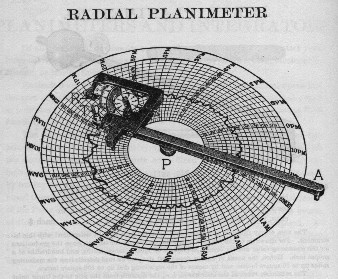
Radial Planimeter

A radial planimeter measures the average radius of a polar graph. The tracer arm has a slot on its underside that fits over a peg that is placed at the pole P of the graph. As the tracer point T is moved along the curve, the tracer arm slides along the peg, which changes the distance between the pole P and the tracer point T. The integrating wheel calculates ∫ r dθ. Dividing this by 2π yields the average radius. By Green's Theorem, this integral equals ∫∫ (1/r) r dr dθ = ∫∫ (1/r) dA, which, when multiplied by the appropriate physical constant, is the electrostatic potential at P of a uniform electric charge spread over the region enclosed by the graph. The point P does not need to lie inside the region.
A radial planimeter can serve as a polar or linear planimeter. The picture above shows a peg on the underside of the tracer arm at A. This peg can be inserted into a pole arm to make a polar planimeter, or into a linear track or heavy rollers to make a linear planimeter. The following picture shows a combination, or universal, planimeter. It can be used as a linear, polar, or radial planimeter. The tracer arm is similar to the one shown above. It is attached to the heavy rollers that roll in a straight line, resulting in a linear planimeter. Also shown is the pole arm. In this model, the tracer arm does not have a peg on its underside at A. Rather it has a hole on its upper side (not visible in the picture). The rollers and the pole arm have pegs that fit into the hole on the tracer arm.Ott Universal Planimeter, 1947
Robert L. Foote
Last update: 29 November 2004